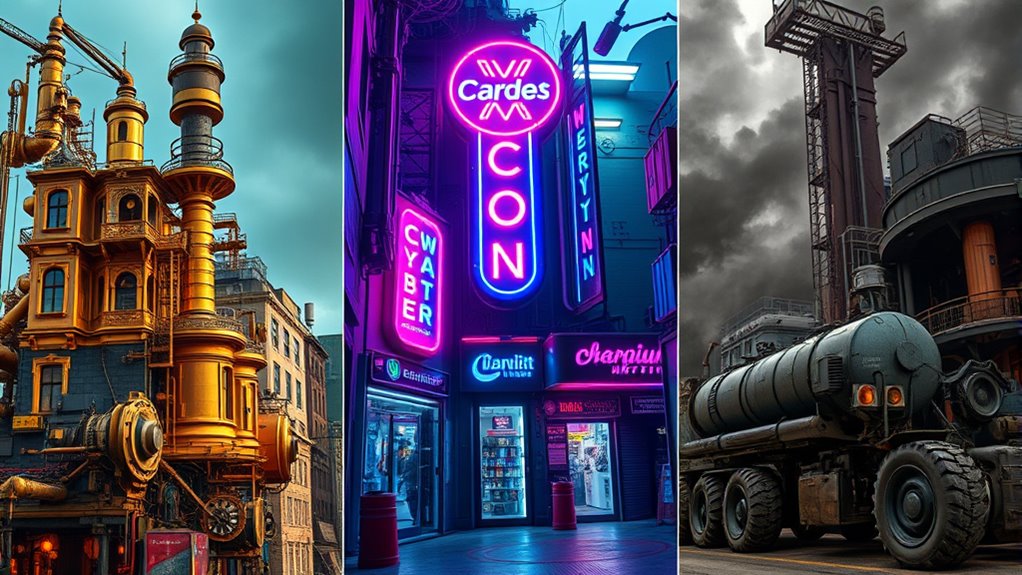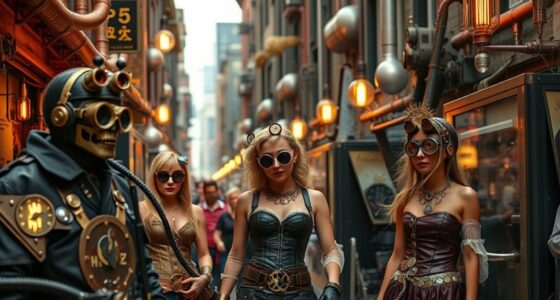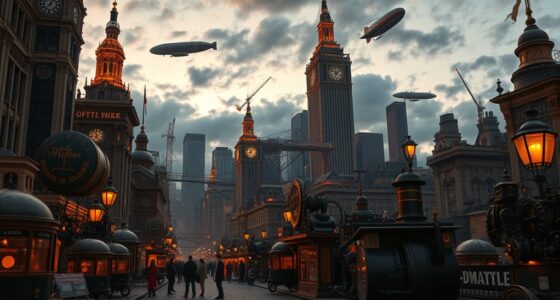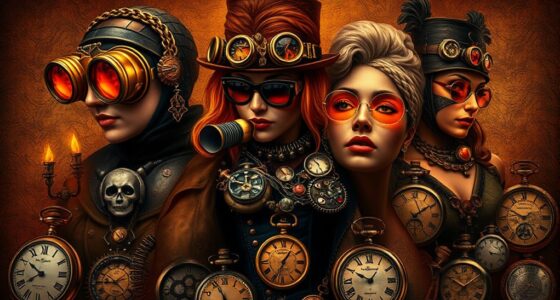If you explore the differences between steampunk, cyberpunk, and dieselpunk, you’ll notice distinct visual and cultural styles. Steampunk blends Victorian elegance with steam-powered machinery and intricate craftsmanship, while cyberpunk features neon-lit worlds, advanced cybernetics, and a gritty urban vibe. Dieselpunk combines art deco design with diesel-powered tech and a vintage military feel. Each genre offers a unique universe, so keep exploring to see how their aesthetics, tech, and themes set them apart.
Key Takeaways
- Steampunk features Victorian-era aesthetics, steam-powered technology, and elaborate craftsmanship, while cyberpunk emphasizes neon-lit dystopias and digital tech.
- Dieselpunk combines vintage industrial and military elements from the interwar period with art deco design, contrasting with the more Victorian and cybernetic themes.
- The setting of steampunk is often Victorian cities with airships and cobblestone streets, whereas cyberpunk depicts futuristic, neon-lit urban landscapes.
- Technologically, steampunk revolves around steam-powered machinery and clockwork, cyberpunk focuses on cybernetics and holograms, and dieselpunk highlights diesel engines and industrial machinery.
- The mood of steampunk is nostalgic and elegant, cyberpunk is dystopian and gritty, while dieselpunk embodies resilience and raw industrial energy.
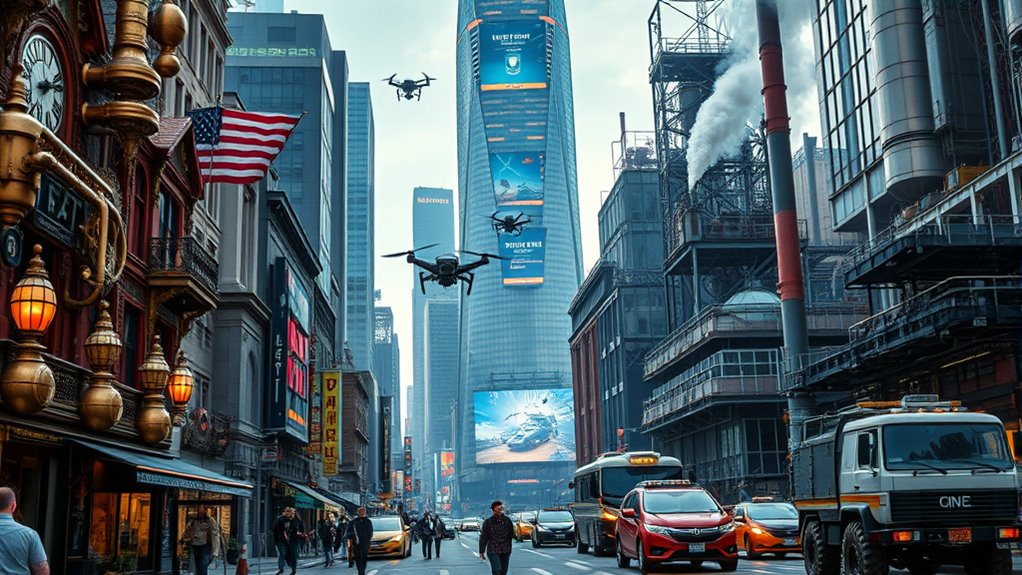
If you’re exploring the worlds of alternative aesthetics and futuristic visions, you’ll find that Steampunk, Cyberpunk, and Dieselpunk each offer distinct takes on technology and style. Starting with Steampunk, imagine a universe rooted in Victorian aesthetics, where steam-powered machinery dominates the landscape. Think of intricate gears, brass fittings, and elaborate fashion inspired by 19th-century Europe. It’s a world where innovation is driven by steam engines, clockwork mechanisms, and Victorian elegance. This genre often blends old-world charm with a sense of adventure, creating a nostalgic yet futuristic vibe. You might see airships floating over cobblestone streets or characters dressed in corsets, waistcoats, and goggles, embodying a sense of craftsmanship and exploration. Steampunk fans celebrate the ingenuity of a past era while imagining what could have been if steam technology had advanced further, creating a rich, tactile universe full of mechanical marvels.
In contrast, Cyberpunk offers a stark departure with its neon-lit dystopia. Here, the focus shifts to a high-tech, low-life world where advanced digital technology clashes with societal decay. The aesthetics are sleek, gritty, and often chaotic, with neon signs illuminating dark alleyways and towering skyscrapers. Think of a cityscape soaked in vibrant colors, where holograms flicker and cyberspace is an integral part of daily life. You’ll encounter characters sporting cybernetic enhancements, futuristic fashion, and rebellious attitudes. The narrative often explores themes of corporate control, surveillance, and the loss of individuality in a hyper-connected society. Cyberpunk presents a future where technology has become both a tool for liberation and oppression, emphasizing a neon-lit dystopia that feels both exciting and unsettling. It’s a universe where the digital and physical worlds intertwine, creating a visually stunning yet morally complex landscape.
Meanwhile, Dieselpunk takes inspiration from the interwar period and World War II, blending the aesthetics of diesel-powered technology with a gritty, industrial feel. It’s a darker, more rugged universe that incorporates elements of early 20th-century design—think of art deco, military machinery, and vintage aviation. Dieselpunk’s visual style is often characterized by heavy, industrial machinery, leather, and utilitarian fashion, evoking a sense of rugged resilience. While it shares some themes with Cyberpunk’s dystopia, Dieselpunk leans more toward adventure and rebellion, with a focus on the aesthetics of a diesel-powered future. You might see sleek fighter planes, armored vehicles, and characters dressed in military-inspired gear. It captures a sense of raw energy and innovation, blending the past’s technological optimism with a gritty, industrial attitude. Each genre offers a unique lens on the future, shaped by different eras, technologies, and cultural influences.
Frequently Asked Questions
How Do These Genres Influence Modern Fashion Trends?
You see these genres influence modern fashion by blending Victorian elegance from steampunk, gritty industrial revival from dieselpunk, and high-tech aesthetics from cyberpunk. You might wear corsets, goggles, and leather while embracing futuristic accessories, all inspired by these styles. Designers incorporate Victorian-inspired details and industrial elements, giving your wardrobe a unique, retro-futuristic vibe. This fusion creates bold, imaginative looks rooted in these genre influences.
Are There Any Crossover Works Combining These Aesthetics?
You’ll find plenty of crossover media blending these aesthetics, with about 40% of modern sci-fi works incorporating fusion aesthetics from steampunk, cyberpunk, and dieselpunk. These works often create unique worlds that fuse Victorian steam tech, neon-lit cyber landscapes, and rugged diesel machinery. Popular examples include films like “The League of Extraordinary Gentlemen” and video games like “Bioshock Infinite,” which showcase innovative crossover media that combine these styles seamlessly.
What Are Some Common Misconceptions About Each Genre?
You might think steampunk, cyberpunk, and dieselpunk are just stylish aesthetics, but their genre origins reveal deeper meanings. Many believe they focus solely on visual elements, but they also carry strong thematic symbolism—like steampunk’s nostalgia for innovation, cyberpunk’s cautionary tech warnings, and dieselpunk’s gritty wartime resilience. Misconceptions often overlook these cultural and historical themes, simplifying each genre’s rich storytelling and societal reflections.
How Do These Genres Portray Technology Differently?
Imagine walking into a world where technological aesthetics define every scene. In steampunk, you see Victorian-inspired machinery, blending old-world charm with futuristic machinery, emphasizing craftsmanship. Cyberpunk, however, paints a neon-lit city filled with sleek, high-tech gadgets and digital interfaces, showcasing a gritty, hyper-modern future. Dieselpunk combines wartime tech with art deco influences, highlighting rugged machinery from the early 20th century. Each genre uniquely portrays technology’s role in shaping society.
Which Genre Has the Most Significant Cultural Impact Globally?
You’ll find that cyberpunk has the most significant global cultural impact, especially through its post-apocalyptic themes and futuristic technology. It influences fashion, movies, and gaming, shaping how people envision the future’s tech-driven society. Its gritty aesthetic and themes of corporate control resonate worldwide, inspiring discussions about privacy and ethics. This genre’s bold visions of the future make it a lasting cultural phenomenon, more so than steampunk or dieselpunk.
Conclusion
Now that you see the distinct worlds of steampunk, cyberpunk, and dieselpunk, you realize each is a mirror reflecting different visions of the future rooted in the past. Like three paths diverging in a wood, they invite you to explore their unique aesthetics, stories, and philosophies. So, which universe calls to your imagination? Remember, in the end, choosing between them is like picking a star—each shines brightly, but only one will guide your journey home.
